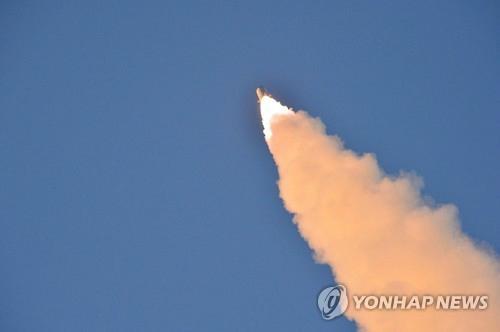NK fires four ballistic missiles; three fall into Japan waters
By Lim Jeong-yeoPublished : March 6, 2017 - 09:27
North Korea on Monday fired four ballistic missiles into the East Sea, Seoul's Joint Chiefs of Staff said, in an apparent reaction to the ongoing joint military drills between South Korea and the United States.
The four projectiles were launched from an area near the North's Dongchang-ri long-range missile site at 7:36 a.m. and flew about 1,000 kilometers before splashing into the East Sea, JCS said in a text message.
"We estimate the North fired four ballistic missiles. We are conducting an analysis (with the US) on the missiles to determine their type and other specifications. It will take a while before we can come up with a final analysis (based on US satellite data)," the JCS said.

Given the number and range of flights, the projectiles do not appear to be intercontinental ballistic missiles capable of reaching the western part of the US mainland, the defense ministry said in a press briefing.
Earlier in the day, military officials raised the possibility that the projectiles could be ICBMs if launched at a high angle.
Experts said the projectiles could be short-range Scud missiles with a range of 500-700 km or mid-range Rodong missiles with a range of 1,300-1,500 km given the number of missiles.
"If North Korea test-fired a new long-range missile, it was not an ICBM as it's not capable of launching multiple ones at the same time," said Kim Dong-yub, an analyst at the Institute for Far Eastern Studies in Kyungnam University.
A more than 6,000-km ICBM could fly far less than the range when launched at a high angle. But as the long-range missile is still being developed and has yet to be deployed, the North could not have fired several missiles, he said.
The North test-fired a long-range ballistic missile at the Dongchang-ri or "Sohae" missile launch site in February last year.
It launched eight ballistic missiles, including three Musudan intermediate-range missiles, during the Foal Eagle drills last year.
The missile launches invited strong condemnations.
South Korea's Acting President and Prime Minister Hwang Kyo-ahn slammed the North during a National Security Council meeting, saying its nuke and missile provocations are "real and imminent threats for the people's lives and security."
The US State Department said the North's missile launches are an explicit violation of UN Security Council resolutions that prohibit the communist state's launches using ballistic missile technology.
"We remain prepared -- and will continue to take steps to increase our readiness -- to defend ourselves and our allies from attack, and are prepared to use the full range of capabilities at our disposal against this growing threat," the State Department's acting spokesman Mark Toner said in a statement.
Japanese Chief Cabinet Secretary Yoshihide Suga said three out of the four missiles fired by the North landed in Japan's Exclusive Economic Zone.
The latest provocation came a day after the US said it may consider redeploying tactical nuclear weapon systems to South Korea as a deterrent against growing nuclear and missile threats posed by the rogue regime.
On Friday, Pyongyang threatened to conduct more missile firings in response to the two-month-long Foal Eagle exercise between Seoul and Washington, which lasts through April.
The Rodong Sinmun, the ruling party's official newspaper, said in a commentary that "new types of strategic weapons will soar" if Seoul and Washington continue their annual war drills.
Seoul and Washington call the annual drills on the Korean Peninsula defensive and routine. But Pyongyang claims they are a preparation for a war against it.
About 28,500 American troops are stationed in South Korea to deter North Korean aggression, a legacy of the 1950-53 Korean War, which ended in a truce, not a peace treaty.
The communist state conducted two nuclear tests and 24 missile launches last year with the aim of eventually building long-range nuclear missiles capable of striking the US mainland.
The US has considered an ICBM test by the North, if perfected, as a major threat to its homeland.
In its previous provocations, Pyongyang launched an intermediate-range ballistic missile into the East Sea on Feb. 12 to boast its military readiness and test the response from the new Donald Trump administration.
It was the first test-firing of a North Korean missile since Trump became US president on Jan. 20 and the country's first major provocation in 2017.
"We sternly warn that North Korea could face collapse if it continues its provocations despite our warnings," the ministry said. (Yonhap)








![[Kim Seong-kon] Democracy and the future of South Korea](http://res.heraldm.com/phpwas/restmb_idxmake.php?idx=644&simg=/content/image/2024/04/16/20240416050802_0.jpg&u=)







![[KH Explains] Hyundai's full hybrid edge to pay off amid slow transition to pure EVs](http://res.heraldm.com/phpwas/restmb_idxmake.php?idx=652&simg=/content/image/2024/04/18/20240418050645_0.jpg&u=20240418181020)

![[Today’s K-pop] Zico drops snippet of collaboration with Jennie](http://res.heraldm.com/phpwas/restmb_idxmake.php?idx=642&simg=/content/image/2024/04/18/20240418050702_0.jpg&u=)